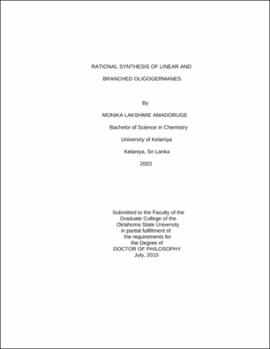| dc.contributor.advisor | Weinert, Charles S. | |
| dc.contributor.author | Amadoruge, Monika Lakshmie | |
| dc.date.accessioned | 2013-11-26T08:21:23Z | |
| dc.date.available | 2013-11-26T08:21:23Z | |
| dc.date.issued | 2010-07 | |
| dc.identifier.uri | https://hdl.handle.net/11244/6443 | |
| dc.description.abstract | Scope and Method of Study: | |
| dc.description.abstract | Group 14 catenates are important because of their intrinsic optical and electronic properties which entirely depends on their structure. However, study of this structure-property relationship in germanium catenates have been less developed compared with silicon and tin analogues due to the lack of synthetic methods to provide the pure compounds in high yield. The purpose of this study was to develop a method to synthesize discrete oligogermanes in good yields and to investigate the correlation between their structure and physical properties. We have developed a method to synthesize oligogermanes in good yields using the hydrogermolysis reaction and those compounds were characterized using 1H NMR, 13C NMR, 73Ge NMR, elemental analyses, UV/vis, CV and X-ray crystallography. | |
| dc.description.abstract | Findings and Conclusions: | |
| dc.description.abstract | We have developed a rational synthetic procedure for the synthesis of oligogermanes using a germanium amide and a germanium hydride. This reaction proceeds in the presence of acetonitrile via the formation of alpha-germyl nitrile, which is the active species of the reaction. Therefore, acetonitrile acts as a solvent as well as a reagent. Along with the hydrogermolysis reaction and the hydride protection/deprotection strategy, we have prepared a myriad of new compounds including both linear and branched oligomers. Using these combined methods, we can systematically change the number of germanium atoms in the molecule as well as the identity of the substituents. The optical properties and the electronic properties that we found correlate with the theoretically calculated values using DFT. Therefore, this synthetic methodology allows both "coarse-tuning" and "fine-tuning" of the properties of the molecule by varying the number of catenated germanium atoms and the identity of the organic substituents respectively. | |
| dc.format | application/pdf | |
| dc.language | en_US | |
| dc.rights | Copyright is held by the author who has granted the Oklahoma State University Library the non-exclusive right to share this material in its institutional repository. Contact Digital Library Services at lib-dls@okstate.edu or 405-744-9161 for the permission policy on the use, reproduction or distribution of this material. | |
| dc.title | Rational synthesis of linear and branched oligogermanes | |
| dc.contributor.committeeMember | Apblett, Allen | |
| dc.contributor.committeeMember | Bunce, Richard A. | |
| dc.contributor.committeeMember | Slaughter, LeGrande M. | |
| dc.contributor.committeeMember | Veenstra, John N. | |
| osu.filename | Amadoruge_okstate_0664D_10995 | |
| osu.accesstype | Open Access | |
| dc.type.genre | Dissertation | |
| dc.type.material | Text | |
| dc.subject.keywords | a-germylated nitriles | |
| dc.subject.keywords | 73ge nmr | |
| dc.subject.keywords | germanium amides | |
| dc.subject.keywords | hydrogermolysis reaction | |
| dc.subject.keywords | oligogermanes | |
| dc.subject.keywords | x-ray chrystallograp | |
| thesis.degree.discipline | Chemistry | |
| thesis.degree.grantor | Oklahoma State University | |
